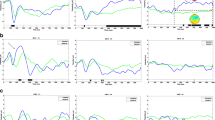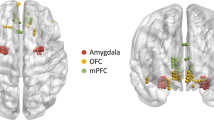Abstract
Mania is characterized by affective and cognitive alterations, with heightened external and self-awareness that are opposite to the alteration of awareness during epileptic seizures. Electrical stimulations carried out routinely during stereotactic intracerebral EEG (SEEG) recordings for presurgical evaluation of epilepsy may represent a unique opportunity to study the pathophysiology of such complex emotional-behavioral phenomenon, particularly difficult to reproduce in experimental setting. We investigated SEEG signals-based functional connectivity between different brain regions involved in emotions and in consciousness processing during a manic state induced by electrical stimulation in a patient with drug-resistant focal epilepsy. The stimulation inducing manic state and an asymptomatic stimulation of the same site, as well as a seizure with alteration of awareness (AOA) were analyzed. Functional connectivity analysis was performed by measuring interdependencies (nonlinear regression analysis based on the h2 coefficient) between broadband SEEG signals and within typical sub-bands, before and after stimulation, or before and during the seizure with AOA, respectively. Stimulation of the right lateral prefrontal cortex induced a manic state lasting several hours. Its onset was associated with significant increase of broadband-signal functional coupling between the right hemispheric limbic nodes, the temporal pole and the claustrum, whereas significant decorrelation between the right lateral prefrontal and the anterior cingulate cortex was observed in theta-band. In contrast, ictal alteration of awareness was associated with increased broadband and sub-bands synchronization within and between the internal and external awareness networks, including the anterior and middle cingulate, the mesial and lateral prefrontal, the inferior parietal and the temporopolar cortex. Our data suggest the existence of network- and frequency-specific functional connectivity patterns during manic state. A transient desynchronization of theta activity between the external and internal awareness network hubs is likely to increase awareness, with potential therapeutic effect.



Similar content being viewed by others
Data Availability
The datasets generated during the current study are available from the corresponding author on reasonable request.
Code Availability
The open-source AnyWave software used to perform signal analyses reported here is available at https://meg.univ-amu.fr/wiki/AnyWave ; a Matlab Plugin required to perform Graph measures is available on request.
References
Arthuis M, Valton L, Rgis J et al (2009) Impaired consciousness during temporal lobe seizures is related to increased long-distance corticalsubcortical synchronization. Brain. https://doi.org/10.1093/brain/awp086
Bartolomei F, Naccache L (2011) The global workspace (GW) theory of consciousness and epilepsy. Behav Neurol 24:67–74. https://doi.org/10.3233/BEN-2011-0313
Bartolomei F, Chauvel P, Wendling F (2008) Epileptogenicity of brain structures in human temporal lobe epilepsy: a quantified study from intracerebral EEG. Brain. https://doi.org/10.1093/brain/awn111
Bartolomei F, Bonini F, Vidal E et al (2016) How does vagal nerve stimulation (VNS) change EEG brain functional connectivity? Epilepsy Res 126:141–146. https://doi.org/10.1016/j.eplepsyres.2016.06.008
Bartolomei F, Lagarde S, Scavarda D et al (2019) The role of the dorsal anterior insula in ecstatic sensation revealed by direct electrical brain stimulation. Brain Stimul. https://doi.org/10.1016/j.brs.2019.06.005
Bickel S, Parvizi J (2019) Electrical stimulation of the human claustrum. Epilepsy Behav. https://doi.org/10.1016/j.yebeh.2019.03.051
Blumenfeld H (2012) Impaired consciousness in epilepsy. Lancet Neurol 11(9):814–826
Colombet B, Woodman M, Badier JM, Bénar CG (2015) AnyWave: a cross-platform and modular software for visualizing and processing electrophysiological signals. J Neurosci Methods. https://doi.org/10.1016/j.jneumeth.2015.01.017
Courtens S, Colombet B, Trébuchon A et al (2016) Graph measures of node strength for characterizing preictal synchrony in partial epilepsy. Brain Connect 6:530–539. https://doi.org/10.1089/brain.2015.0397
Crick FC, Koch C (2005) What is the function of the claustrum? Philos Trans R Soc B Biol Sci 360:1271–1279. https://doi.org/10.1098/rstb.2005.1661
Filipescu C, Lagarde S, Lambert I et al (2019) The effect of medial pulvinar stimulation on temporal lobe seizures. Epilepsia. https://doi.org/10.1111/epi.14677
Gschwind M, Picard F (2016) Ecstatic epileptic seizures: a glimpse into the multiple roles of the insula. Front Behav Neurosci. https://doi.org/10.3389/fnbeh.2016.00021
Guo JN, Kim R, Chen Y et al (2016) Mechanism of impaired consciousness in absence seizures: a cross-sectional study. Lancet Neurol 15:1336–1345. https://doi.org/10.1038/nmeth.2839.A
Herweg NA, Kahana MJ (2018) Spatial representations in the human brain. Front Hum Neurosci 12:297. https://doi.org/10.3389/fnhum.2018.00297
Johnson EL, King-Stephens D, Weber PB et al (2019) Spectral imprints of working memory for everyday associations in the frontoparietal network. Front Syst Neurosci 12:1–12. https://doi.org/10.3389/fnsys.2018.00065
Koubeissi MZ, Bartolomei F, Beltagy A, Picard F (2014) Electrical stimulation of a small brain area reversibly disrupts consciousness. Epilepsy Behav 37:32–35. https://doi.org/10.1016/j.yebeh.2014.05.027
Lambert I, Arthuis M, McGonigal A et al (2012) Alteration of global workspace during loss of consciousness: a study of parietal seizures. Epilepsia. https://doi.org/10.1111/j.1528-1167.2012.03690.x
Lee I, Nielsen K, Hall MH et al (2019) Diverse pathophysiological processes converge on network disruption in mania. J Affect Disord 244:115–123. https://doi.org/10.1016/j.jad.2018.10.087
Lois G, Linke J, Wessa M (2014) Altered functional connectivity between emotional and cognitive resting state networks in euthymic bipolar I disorder patients. PLoS ONE. https://doi.org/10.1371/journal.pone.0107829
Medina Villalon S, Paz R, Roehri N et al (2018) EpiTools, a software suite for presurgical brain mapping in epilepsy: intracerebral EEG. J Neurosci Methods 303:7–15. https://doi.org/10.1016/j.jneumeth.2018.03.018
Mina F, Modolo J, Recher F et al (2017) Model-guided control of hippocampal discharges by local direct current stimulation. Sci Rep 7:1708. https://doi.org/10.1038/s41598-017-01867-1
Pessoa L (2008) On the relationship between emotion and cognition. Nat Rev Neurosci 9:148–158
Phillips M, Ladouceur C, Drevets W (2008) Automatic and volontary regulation of emotion. Mol Psychiatry 13:829–857. https://doi.org/10.1038/mp.2008.65.A
Picard F, Scavarda D, Bartolomei F (2013) Induction of a sense of bliss by electrical stimulation of the anterior insula. Cortex 49:2935–2937. https://doi.org/10.1016/j.cortex.2013.08.013
Proix T, Bartolomei F, Guye M, Jirsa VK (2017) Individual brain structure and modelling predict seizure propagation. Brain. https://doi.org/10.1093/brain/awx004
Roberts G, Perry A, Lord A et al (2018) Structural dysconnectivity of key cognitive and emotional hubs in young people at high genetic risk for bipolar disorder. Mol Psychiatry 23:413–421. https://doi.org/10.1038/mp.2016.216
Smythies J, Edelstein L, Ramachandran V (2014) Hypotheses relating to the function of the claustrum II: does the claustrum use frequency codes? Front Integr Neurosci 8:2012–2014. https://doi.org/10.3389/fnint.2014.00007
Wendling F, Bartolomei F, Bellanger JJ, Chauvel P (2001) Interpretation of interdependencies in epileptic signals using a macroscopic physiological model of the EEG. Clin Neurophysiol. https://doi.org/10.1016/S1388-2457(01)00547-8
Wendling F, Benquet P, Bartolomei F, Jirsa V (2016) Computational models of epileptiform activity. J Neurosci Methods 260:233–251. https://doi.org/10.1016/j.jneumeth.2015.03.027
Wessa M, Kanske P, Linke J (2014) Bipolar disorder: a neural network perspective on a disorder of emotion and motivation. Restor Neurol Neurosci 32:51–62. https://doi.org/10.3233/RNN-139007
Young RC, Biggs JT, Ziegler VE, Meyer DA (1978) A rating scale for mania: reliability, validity and sensitivity. Br J Psychiatry 133:429–435
Acknowledgements
We thank Pr François Proust and Dr Mustapha Benmekhbi for the surgical management of the patient.
Funding
This research did not receive any specific grant from funding agencies in the public, commercial, or not-for-profit sectors.
Author information
Authors and Affiliations
Contributions
JS, AG, CGB, and FB: conceptualization and design of the study; JS, AG, MB, AT and MPVH: acquiring the data; CGB: Software; JS, CGB and FB: data analysis: JS, AG, CGB: Original draft and the figures; JS, AG, MG, MB, AT, MPVH, PV, EH, CGB and FB: review and editing of the manuscript.
Corresponding author
Ethics declarations
Conflict of interest
None of the authors have conflicts of interests to be disclosed.
Ethical Approval
This study was performed in line with the principles of the Declaration of Helsinki. The institutional review board of the French Institute of Health (IRB00003888) approved this study.
Consent to Participate
Written informed consent was obtained from the patient.
Consent for Publication
The patient has consented to the publication of his data in the informed consent.
Additional information
Handling Editor: Dr. Patrik Vuilleumier.
Publisher’s Note
Springer Nature remains neutral with regard to jurisdictional claims in published maps and institutional affiliations.
Supplementary Information
Below is the link to the electronic supplementary material.
10548_2022_913_MOESM1_ESM.tif
Supplementary material 1 (TIF 1719.0 kb)
Supplementary Fig. 1 Ictal SEEG findings and organization of the epileptogenic zone. A Visualization of the depth electrodes on the 3d-mesh of the patient’s brain (Epitools software suite, Medina-Villalon et al. 2018). Reconstructed electrode images (blue) correspond to real trajectories and entry points. Right hemisphere: Electrode I sampled the rhinal cortex and the lateral aspect of the temporal pole; electrode O sampled the gyrus rectus, the orbitofrontal cortex and the pars orbitalis of the F3; electrode H recorded the mesial prefrontal aspect of the F1, the inferior frontal sulcus (IFS) and the F3; electrode G recorded the antero-superior insula and the pars triangularis of the F3 (F3 Triang); electrode OR recorded the claustrum, the anterior insula and the central operculum (Cop); electrode FP recorded the frontal pole (Fpol); electrode X sampled the anterior cingulate cortex (ACC) and the rostral F2; electrode CA sampled anterior part of the middle cingulate cortex (aMCC) and the pars opercularis of the F3 (FOp); electrode CM recorded the aMCC, the precentral sulcus at the junction with the IFS and the precentral gyrus (PreM lat); electrode FL sampled the mesial prefrontal aspect of the F1 (PreF mes) and the rostral F2; electrode FM recorded the orbito-frontal cortex, the rostral part of the superior frontal sulcus (SFS) and the rostral F2 (PreF lat); electrode PM sampled the preSMA, the caudal aspect of the SFS and the caudal F2; electrode M recorded the SMA, the premotor aspect of the F1 and the superior part of the precentral sulcus; electrode P sampled the posterior cingulate cortex (PCC) and the supramarginal gyrus (PAR). Left hemisphere: electrode FM’ recorded the orbito-frontal cortex and the rostral F2; electrode CA’ recorded anterior part of the middle cingulate cortex and the caudal F2. B SEEG recording of a patient’s typical seizure of type 1 that starts from the right lateral premotor cortex and the central operculum, with simultaneous involvement of the posterior cingulate and lateral parietal cortex, as well as of the preSMA, with a less tonic discharge within these structures. Note the brief implication of the prefrontal structures at seizure onset without sustained discharge. C Quantitative estimation of epileptogenicity at seizure onset by the Epileptogenicity Index (EI, Bartolomei et al. 2008). Left and right diagrams show the normalized EI values obtained in different recorded structures in two spontaneous seizures. In the seizure type 1, the right lateral premotor and the central operculum show the maximal epileptogenicity values. The seizure type 2 is characterized by a much more extended epileptogenic network, with high EI values within the right lateral prefrontal, fronto-polar, fronto-opercular, the lateral premotor, and the lateral parietal regions
Supplementary material 2 (TIF 1486.0 kb)
Supplementary Fig. 2 Functional connectivity changes in broadband and theta-band SEEG signals during ictal alteration of awareness. A SEEG dataset of a seizure with alteration of awareness (AOA), characterized by a vast ictal discharge simultaneously involving the right fronto-parietal, insular and anterior temporal structures. The begin of AOA is indicated by a black arrow, and two analyzed periods of interest are outlined in blue (seizure onset) and orange (seizure end), respectively. The differences in mean degree between the background (red bars) and the seizure end period (green bars), corresponding to ictal AOA, are shown for the broadband band (B) and for the theta band (C). * indicate significant changes (*p < 0.05 after Bonferroni corrections). Bipolar channels selected for connectivity analysis: Right hemisphere, O2-O3, the orbitofrontal cortex/G. rectus ; G1-G2, the anterior superior insula ; OR1-OR2, the claustrum ; X1-X2, the anterior cingulate cortex ; CM2-CM3, anterior part of the middle cingulate cortex ; CM13-CM14, the precentral sulcus (inferior part) ; FL2-FL3, mesial prefrontal aspect of the F1 ; FM13-FM14, the rostral F2 ; FP11-FP12, the frontal pole ; P1-P2, the posterior cingulate gyrus ; P9-P10, the supramarginal gyrus ; I1-I2, the rhinal cortex ; I7-I8, the temporal pole. Left hemisphere : FM’1-FM’2, the orbitofrontal cortex ; FM’13-FM’14, the rostral F2 ; CA’1-CA’2, the anterior part of the middle cingulate cortex
Rights and permissions
Springer Nature or its licensor holds exclusive rights to this article under a publishing agreement with the author(s) or other rightsholder(s); author self-archiving of the accepted manuscript version of this article is solely governed by the terms of such publishing agreement and applicable law.
About this article
Cite this article
Scholly, J., Gras, A., Guye, M. et al. Connectivity Alterations in Emotional and Cognitive Networks During a Manic State Induced by Direct Electrical Stimulation. Brain Topogr 35, 627–635 (2022). https://doi.org/10.1007/s10548-022-00913-0
Received:
Accepted:
Published:
Issue Date:
DOI: https://doi.org/10.1007/s10548-022-00913-0




